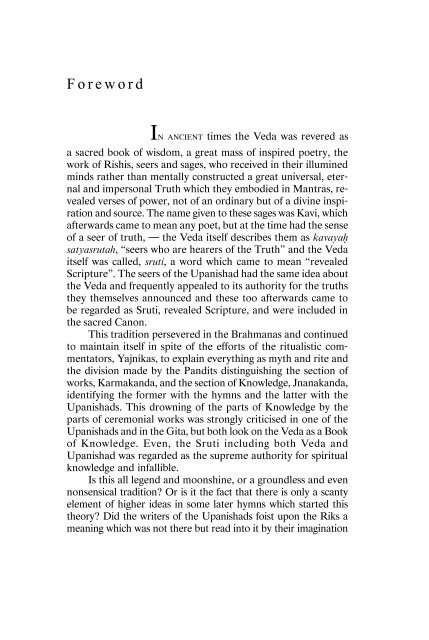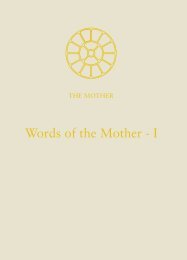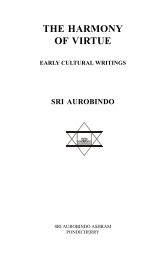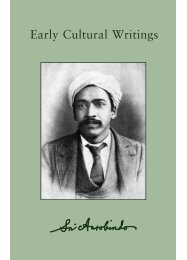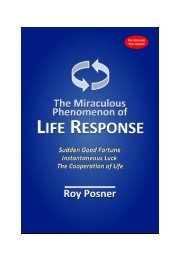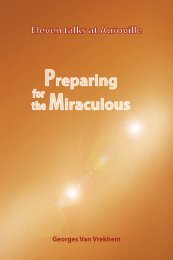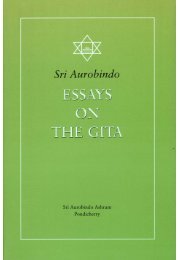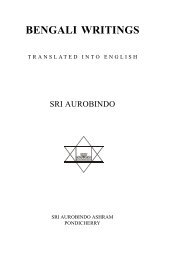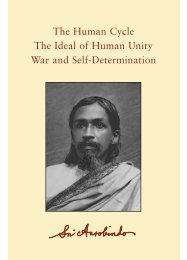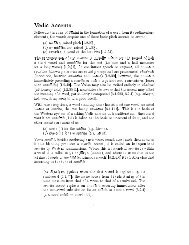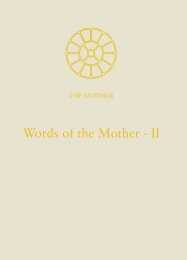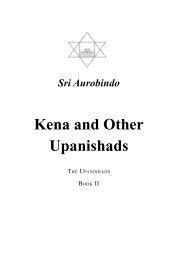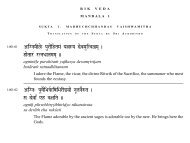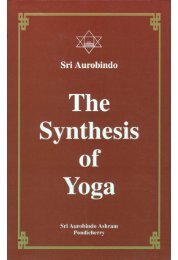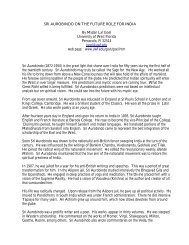- Page 2 and 3: VOLUME NO.11 Sri Aurobindo Birth Ce
- Page 6 and 7: Foreword countries these gods began
- Page 8 and 9: Foreword small or however swelled b
- Page 10 and 11: Foreword ther that “the Rishis sa
- Page 12 and 13: Foreword call occultists, men who b
- Page 14 and 15: Foreword it is something which Thou
- Page 16 and 17: Foreword spiritual strength, force
- Page 18 and 19: Foreword truth, Ðtam, spoken of in
- Page 20 and 21: Foreword immortality towards which
- Page 22 and 23: Foreword and sixth Mandalas are now
- Page 24 and 25: The Doctrine of the Mystics THE Ved
- Page 26 and 27: But other principles intervene and
- Page 28 and 29: The Doctrine of the Mystics holds i
- Page 30 and 31: The Doctrine of the Mystics the cos
- Page 32 and 33: The Doctrine of the Mystics enemies
- Page 34 and 35: The Doctrine of the Mystics the los
- Page 36 and 37: The Doctrine of the Mystics perfect
- Page 38: The Doctrine of the Mystics Song of
- Page 42 and 43: MADHUCHCHHANDAS VAISHWAMITRA SUKTA
- Page 44 and 45: Mandala One To the Lord of the crea
- Page 46 and 47: Mandala One O Fire! perfectly kindl
- Page 48 and 49: Mandala One 1-014-08 ye yj]a y ¡@)
- Page 50 and 51: Mandala One It is in thee, O Agni,
- Page 52 and 53: Mandala One As with thick falling b
- Page 54 and 55:
Mandala One sun-world, its many mig
- Page 56 and 57:
Mandala One is as if our eternal ch
- Page 58 and 59:
He who in the growths of earth hold
- Page 60 and 61:
glad horse of swiftness he carries
- Page 62 and 63:
Mandala One SUKTA 71 1-071-01 £p p
- Page 64 and 65:
Mandala One He who travels the path
- Page 66 and 67:
the carrier of the offerings. 1-072
- Page 68 and 69:
uddered, desiring us, have fed us w
- Page 70 and 71:
Mandala One extend our being and cr
- Page 72 and 73:
Mandala One God art thou of the god
- Page 74 and 75:
Mandala One Let thy face front the
- Page 76 and 77:
Mandala One the day, for his undepa
- Page 78 and 79:
Mandala One enjoying; for those who
- Page 80 and 81:
Mandala One divine; uniting, anothe
- Page 82:
MANDALA TWO
- Page 85 and 86:
82 Hymns to the Mystic Fire law of
- Page 87 and 88:
84 Hymns to the Mystic Fire our way
- Page 89 and 90:
86 Hymns to the Mystic Fire awakens
- Page 91 and 92:
88 Hymns to the Mystic Fire 2-002-1
- Page 93 and 94:
90 Hymns to the Mystic Fire Bharati
- Page 95 and 96:
92 Hymns to the Mystic Fire light;
- Page 97 and 98:
94 Hymns to the Mystic Fire and aga
- Page 99 and 100:
96 Hymns to the Mystic Fire 2-006-0
- Page 101 and 102:
98 Hymns to the Mystic Fire He shin
- Page 103 and 104:
100 Hymns to the Mystic Fire SUKTA
- Page 106:
MANDALA THREE
- Page 109 and 110:
106 Hymns to the Mystic Fire 3-001-
- Page 111 and 112:
108 Hymns to the Mystic Fire 3-001-
- Page 113 and 114:
110 Hymns to the Mystic Fire O Fire
- Page 115 and 116:
112 Hymns to the Mystic Fire vast T
- Page 117 and 118:
114 Hymns to the Mystic Fire 3-003-
- Page 119 and 120:
116 Hymns to the Mystic Fire O univ
- Page 121 and 122:
118 Hymns to the Mystic Fire pleasu
- Page 123 and 124:
120 Hymns to the Mystic Fire 3-005-
- Page 125 and 126:
122 Hymns to the Mystic Fire thou h
- Page 127 and 128:
124 Hymns to the Mystic Fire SUKTA
- Page 129 and 130:
126 Hymns to the Mystic Fire 3-007-
- Page 131 and 132:
128 Hymns to the Mystic Fire with h
- Page 133 and 134:
130 Hymns to the Mystic Fire SUKTA
- Page 135 and 136:
132 Hymns to the Mystic Fire 3-012-
- Page 137 and 138:
134 Hymns to the Mystic Fire May he
- Page 139 and 140:
136 Hymns to the Mystic Fire 3-014-
- Page 141 and 142:
138 Hymns to the Mystic Fire progen
- Page 143 and 144:
140 Hymns to the Mystic Fire We hym
- Page 145 and 146:
142 Hymns to the Mystic Fire O Fire
- Page 147 and 148:
144 Hymns to the Mystic Fire Found
- Page 149 and 150:
146 Hymns to the Mystic Fire action
- Page 151 and 152:
148 Hymns to the Mystic Fire 3-024-
- Page 153 and 154:
150 Hymns to the Mystic Fire 3-026-
- Page 155 and 156:
152 Hymns to the Mystic Fire pray,
- Page 157 and 158:
154 Hymns to the Mystic Fire SUKTA
- Page 159 and 160:
156 Hymns to the Mystic Fire of the
- Page 161 and 162:
158 Hymns to the Mystic Fire pra sa
- Page 164 and 165:
VAMADEVA GAUTAMA SUKTA 1 4-001-01 T
- Page 166 and 167:
Mandala Four 163 shining in his bea
- Page 168 and 169:
Mandala Four 4-001-15 te gVyta mnsa
- Page 170 and 171:
Mandala Four 4-002-04 AyRm,' vä,'
- Page 172 and 173:
Mandala Four 169 4-002-13 TvmGne va
- Page 174 and 175:
Mandala Four 171 Create for yoursel
- Page 176 and 177:
Mandala Four 4-003-10 ©ten ih Zma
- Page 178 and 179:
Mandala Four 4-004-02 tv .mas Aaxuy
- Page 180 and 181:
Mandala Four 4-004-11 mho äjaim bN
- Page 182 and 183:
Mandala Four 179 Going they go on t
- Page 184 and 185:
Mandala Four 181 Those who live und
- Page 186 and 187:
Mandala Four 4-006-08 iÜy| pHc jIj
- Page 188 and 189:
Mandala Four 185 Him in the many mo
- Page 190 and 191:
Mandala Four 4-008-05 te Syam ye AG
- Page 192 and 193:
Mandala Four 189 Let thy invincible
- Page 194 and 195:
Mandala Four 191 O Fire, O thou wit
- Page 196 and 197:
Mandala Four 4-012-05 mhiXcdGn Enso
- Page 198 and 199:
Mandala Four 4-014-03 AavhNTyä,IJy
- Page 200 and 201:
Mandala Four eØa vÀÌ devÀvaÙvi
- Page 202:
MANDALA FIVE THE ATRIS
- Page 205 and 206:
202 Hymns to the Mystic Fire 5-001-
- Page 207 and 208:
204 Hymns to the Mystic Fire The yo
- Page 209 and 210:
206 Hymns to the Mystic Fire undivi
- Page 211 and 212:
208 Hymns to the Mystic Fire 5-003-
- Page 213 and 214:
210 Hymns to the Mystic Fire 5-004-
- Page 215 and 216:
212 Hymns to the Mystic Fire 5-005-
- Page 217 and 218:
214 Hymns to the Mystic Fire 5-006-
- Page 219 and 220:
216 Hymns to the Mystic Fire mighty
- Page 221 and 222:
218 Hymns to the Mystic Fire O Fire
- Page 223 and 224:
220 Hymns to the Mystic Fire Fire i
- Page 225 and 226:
222 Hymns to the Mystic Fire ters,
- Page 227 and 228:
224 Hymns to the Mystic Fire To Fir
- Page 229 and 230:
226 Hymns to the Mystic Fire Thee h
- Page 231 and 232:
228 Hymns to the Mystic Fire cross
- Page 233 and 234:
230 Hymns to the Mystic Fire By his
- Page 235 and 236:
232 Hymns to the Mystic Fire come c
- Page 237 and 238:
234 Hymns to the Mystic Fire thee;
- Page 239 and 240:
236 Hymns to the Mystic Fire for th
- Page 241 and 242:
238 Hymns to the Mystic Fire 5-025-
- Page 243 and 244:
240 Hymns to the Mystic Fire 5-026-
- Page 245 and 246:
242 Hymns to the Mystic Fire For th
- Page 247 and 248:
244 Hymns to the Mystic Fire on the
- Page 250 and 251:
BHARADWAJA BARHASPATYA SUKTA 1 6-00
- Page 252 and 253:
Mandala Six 249 fuel of thy flame a
- Page 254 and 255:
Mandala Six 6-002-06 TvezSte /Um ©
- Page 256 and 257:
Mandala Six 253 force of battle. Th
- Page 258 and 259:
Mandala Six 6-004-04 vÚa ih sUno A
- Page 260 and 261:
Mandala Six 6-005-04 yo n" snuTyo A
- Page 262 and 263:
Mandala Six 6-006-06 Aa .anuna paiq
- Page 264 and 265:
Mandala Six SUKTA 8 261 6-008-01 p*
- Page 266 and 267:
Mandala Six 6-009-02 nah' tNtu' n i
- Page 268 and 269:
Mandala Six 265 He among mortals is
- Page 270 and 271:
Mandala Six bringer of their satisf
- Page 272 and 273:
Mandala Six SUKTA 13 6-013-01 TviÜ
- Page 274 and 275:
Mandala Six 271 Destroyer seek to o
- Page 276 and 277:
Mandala Six 273 He shines with the
- Page 278 and 279:
Mandala Six 6-015-14 AGne ydÛ ivxo
- Page 280 and 281:
Mandala Six 6-016-04 TvamI¬w A/ i
- Page 282 and 283:
Mandala Six 6-016-16 Eö zu bvai, t
- Page 284 and 285:
Mandala Six 281 These are thy men w
- Page 286 and 287:
Mandala Six 283 the refuge of thy p
- Page 288:
MANDALA SEVEN
- Page 291 and 292:
288 Hymns to the Mystic Fire full o
- Page 293 and 294:
290 Hymns to the Mystic Fire 7-001-
- Page 295 and 296:
292 Hymns to the Mystic Fire SUKTA
- Page 297 and 298:
294 Hymns to the Mystic Fire discer
- Page 299 and 300:
296 Hymns to the Mystic Fire stand
- Page 301 and 302:
298 Hymns to the Mystic Fire 7-004-
- Page 303 and 304:
300 Hymns to the Mystic Fire Into t
- Page 305 and 306:
302 Hymns to the Mystic Fire 7-006-
- Page 307 and 308:
304 Hymns to the Mystic Fire SUKTA
- Page 309 and 310:
306 Hymns to the Mystic Fire the ma
- Page 311 and 312:
308 Hymns to the Mystic Fire Men wh
- Page 313 and 314:
310 Hymns to the Mystic Fire SUKTA
- Page 315 and 316:
312 Hymns to the Mystic Fire Now ha
- Page 317 and 318:
314 Hymns to the Mystic Fire SUKTA
- Page 319 and 320:
316 Hymns to the Mystic Fire They w
- Page 322:
MANDALA EIGHT
- Page 325 and 326:
322 Hymns to the Mystic Fire the im
- Page 327 and 328:
324 Hymns to the Mystic Fire 8-019-
- Page 329 and 330:
326 Hymns to the Mystic Fire which
- Page 331 and 332:
328 Hymns to the Mystic Fire 8-019-
- Page 333 and 334:
330 Hymns to the Mystic Fire VISHWA
- Page 335 and 336:
332 Hymns to the Mystic Fire 8-023-
- Page 337 and 338:
334 Hymns to the Mystic Fire 8-023-
- Page 339 and 340:
336 Hymns to the Mystic Fire 8-038-
- Page 341 and 342:
338 Hymns to the Mystic Fire alien
- Page 343 and 344:
340 Hymns to the Mystic Fire tÀ hi
- Page 345 and 346:
342 Hymns to the Mystic Fire evendr
- Page 347 and 348:
344 Hymns to the Mystic Fire May we
- Page 349 and 350:
346 Hymns to the Mystic Fire Such a
- Page 351 and 352:
348 Hymns to the Mystic Fire Set to
- Page 353 and 354:
350 Hymns to the Mystic Fire 8-044-
- Page 355 and 356:
352 Hymns to the Mystic Fire Fire t
- Page 357 and 358:
354 Hymns to the Mystic Fire Flame
- Page 359 and 360:
356 Hymns to the Mystic Fire 8-060-
- Page 361 and 362:
358 Hymns to the Mystic Fire Thou b
- Page 363 and 364:
360 Hymns to the Mystic Fire Do you
- Page 365 and 366:
362 Hymns to the Mystic Fire À sut
- Page 367 and 368:
364 Hymns to the Mystic Fire 8-074-
- Page 369 and 370:
366 Hymns to the Mystic Fire the ca
- Page 371 and 372:
368 Hymns to the Mystic Fire 8-075-
- Page 373 and 374:
370 Hymns to the Mystic Fire 8-084-
- Page 375 and 376:
372 Hymns to the Mystic Fire viÙve
- Page 377 and 378:
374 Hymns to the Mystic Fire SOBHAR
- Page 379 and 380:
376 Hymns to the Mystic Fire 8-103-
- Page 382 and 383:
TRITA APTYA SUKTA 1 10-001-01 Ag[e
- Page 384 and 385:
Mandala Ten 381 Thou comest to men'
- Page 386 and 387:
Mandala Ten 10-003-04 ASy yamaso b*
- Page 388 and 389:
Mandala Ten 385 Two robbers abandon
- Page 390 and 391:
Mandala Ten SUKTA 6 10-006-01 Ay' s
- Page 392 and 393:
Mandala Ten 389 herds of light when
- Page 394 and 395:
Mandala Ten 10-008-04 £z£zo ih vs
- Page 396 and 397:
Mandala Ten 393 out for man bringin
- Page 398 and 399:
Mandala Ten 395 When perfectly achi
- Page 400 and 401:
Mandala Ten 397 Fire whom face to f
- Page 402 and 403:
Mandala Ten 399 In thee the upholdi
- Page 404 and 405:
Mandala Ten 401 Fire cried aloud li
- Page 406 and 407:
Mandala Ten pra hotÀ jÀto mahÀn
- Page 408 and 409:
Mandala Ten 405 10-046-10 y' Tva de
- Page 410 and 411:
Mandala Ten 407 10-051-09 tv p[yaja
- Page 412 and 413:
Mandala Ten 409 O Fire, thou art se
- Page 414 and 415:
Mandala Ten 411 Touch either heaven
- Page 416 and 417:
Mandala Ten 413 10-079-03 p[ matu"
- Page 418 and 419:
Mandala Ten 10-080-05 AiGnmuKqWâ©
- Page 420 and 421:
Mandala Ten 417 mid-air, a shooter
- Page 422 and 423:
Mandala Ten onset of each and every
- Page 424 and 425:
Mandala Ten ARUNA VAITAHAVYA SUKTA
- Page 426 and 427:
423 the seekers of the godhead hold
- Page 428 and 429:
Mandala Ten 425 the mantras and the
- Page 430 and 431:
Mandala Ten UPASTUTA VARSHTIHAVYA S
- Page 432 and 433:
Mandala Ten 429 Thus have extolled
- Page 434 and 435:
Mandala Ten AGNI PAVAKA SUKTA 140 1
- Page 436 and 437:
Mandala Ten 10-150-04 AiGndŠvo dev
- Page 438 and 439:
Mandala Ten may he carry us through
- Page 440:
SUPPLEMENT The following notes and
- Page 443 and 444:
440 Hymns to the Mystic Fire and co
- Page 445 and 446:
442 Hymns to the Mystic Fire light;
- Page 447 and 448:
444 Hymns to the Mystic Fire vital
- Page 449 and 450:
446 Hymns to the Mystic Fire proper
- Page 451 and 452:
448 Hymns to the Mystic Fire agan,
- Page 453 and 454:
450 Hymns to the Mystic Fire increa
- Page 455 and 456:
452 Hymns to the Mystic Fire the Tr
- Page 457 and 458:
454 Hymns to the Mystic Fire Veda i
- Page 459 and 460:
456 Hymns to the Mystic Fire But in
- Page 461 and 462:
458 Hymns to the Mystic Fire sure,
- Page 463 and 464:
460 Hymns to the Mystic Fire ©iTvj
- Page 465 and 466:
462 Hymns to the Mystic Fire (yat),
- Page 467 and 468:
464 Hymns to the Mystic Fire (1) wo
- Page 469 and 470:
466 Hymns to the Mystic Fire gested
- Page 471 and 472:
468 Hymns to the Mystic Fire and ra
- Page 473 and 474:
470 Hymns to the Mystic Fire consid
- Page 475 and 476:
472 Hymns to the Mystic Fire mind m
- Page 477 and 478:
474 Hymns to the Mystic Fire Veda a
- Page 479 and 480:
476 Hymns to the Mystic Fire too fu
- Page 481 and 482:
478 Hymns to the Mystic Fire only w
- Page 483 and 484:
480 Hymns to the Mystic Fire charac
- Page 485 and 486:
482 Hymns to the Mystic Fire spirit
- Page 487 and 488:
484 Hymns to the Mystic Fire CRITIC
- Page 489 and 490:
486 Hymns to the Mystic Fire we the
- Page 491 and 492:
488 Hymns to the Mystic Fire he is
- Page 493 and 494:
A Great God has been Released TRANS
- Page 495 and 496:
492 Hymns to the Mystic Fire EXPLAN
- Page 497 and 498:
494 Hymns to the Mystic Fire abodhi
- Page 499 and 500:
496 Hymns to the Mystic Fire suppor
- Page 501 and 502:
498 Hymns to the Mystic Fire state,
- Page 503 and 504:
500 Hymns to the Mystic Fire in the
- Page 505 and 506:
502 Hymns to the Mystic Fire iddha
- Page 508 and 509:
Word-Formation THE language of man
- Page 510 and 511:
Contents FOREWORD .................
- Page 512 and 513:
SUKTA 13 ..........................
- Page 514 and 515:
VIRUPA ANGIRASA. SUKTA 75 .........


